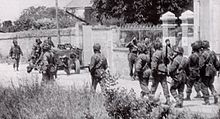Battle of Bréville
From this vantage point, they could observe the positions of the 6th Airborne Division, defending the River Orne and Caen Canal bridges and beyond them the British Sword at Ouistreham.[6] The two remaining brigades dug in along a ridge of high ground that, if lost, offered the Germans a position to look down on the British landing zone.Located on the ridge line it gave the Germans a view into Ranville, at the heart of the British position, the two captured bridges and in the distance Sword.[8] The Germans reoccupied the village and formed their own defensive positions, facing the ridge line defended by 6th Airborne Division.They found it abandoned, but the presence of clothing, equipment, a half-eaten meal and a payroll containing 50,000 French francs betrayed the recent German occupancy.[11] After suffering many casualties, the Germans retreated into the woods surrounding the Château, where they reformed and made another abortive attack an hour later.Soon afterward, Royal Air Force Short Stirling bombers arrived to carry out a parachute supply drop for the division.At 08:00 a massive artillery and mortar bombardment fell along the 1st Special Service Brigade lines, while the 857th Grenadier Regiment, which had gathered in the village, attacked No.Shortly afterwards the battalion killed around fifty Germans, who had started digging defences in full view of the British position.That afternoon a strong force of Germans occupied the Château and used it as a base to start an infantry and self propelled gun assault on the British battalion.This assault was more determined, even naval gunfire support from the 6-inch (150 mm) guns of HMS Arethusa did not stop the attack.[19] In the fighting the only British casualties were ten wounded in the parachute battalion, but eight men from the Hussars were killed and four Sherman medium and two Stuart light tanks were destroyed.The Black Watch were informed to prepare for an assault to capture Bréville and formed up to the rear of the 9th Parachute Battalion, ready to begin their attack the next day.To reach Bréville the battalion had to cross 250 yards (230 m) of open ground, and when they neared the village the British artillery ceased fire.[26] At midday on 12 June the entire 3rd Parachute Brigade position came under artillery and mortar fire prior to a major attack scheduled to start at 15:00.Unable to resist they were forced to pull back to the Bois de Mont, joining the 9th Parachute Battalion, which was being attacked by the German armoured vehicles.To support the assault and destroy a German position 200 yards (180 m) from the start line, two troop of Sherman tanks A Squadron 13/18 Hussars would accompany them.Repeatedly hit by the artillery and tanks, Bréville was in flames by the time the company's fifteen survivors reached the village.However, there was a misunderstanding when the order reached the artillery and a heavy bombardment landed on the British positions in the village, causing several casualties including three of the surviving officers.But there were too few to defend against a German counter-attack, so the 1st Battalion Royal Ulster Rifles, part of the 6th Airlanding Brigade, was moved into the village to take over from the survivors of the attack.[4][36] The German defenders from the 3rd Battalion 858th Grenadier Regiment, had numbered 564 men before the British assault, by the time the village had been captured there were only 146 of them left.The next two months was a period of static warfare, until 17 August when the division crossed the River Dives and advanced north along the French coast.By 26 August they had reached Honfleur at the mouth of the River Seine, capturing over 1,000 prisoners and liberating 1,000 square kilometres (390 sq mi) of France.





Operation OverlordBréville-les-MontsUnited KingdomGermanyRichard Nelson GaleJohnny JohnsonLord LovatErich Diestel6th Airborne Division346th Infantry DivisionAtlantic WallBodyguardFortitudeZeppelinTitanicTaxable, Glimmer & Big DrumCombined Bomber OffensivePointblankTransport PlanPostage AbleTarbrushFabiusCaen canal and Orne river bridgesMerville BatteryMallardAmerican SectorAlbanyBostonChicagoDetroitElmiraNormandy landingsPointe du HocGambitPort-en-BessinAmericanOperation ChastityBritishMulberryBrécourt ManorGraignesLa Haye-du-PuitsSaint-LôCarentanHill 30CherbourgVillers-BocageLe Mesnil-PatryNormandy massacresArdenne AbbeyDouvresMartletWindsorCharnwoodJupiter2nd OdonAtlanticGoodwoodVerrières RidgeSpringBluecoatTotalizeHill 140LüttichTractableHill 262ChamboisFalaiseSaint-MaloMantes-GassicourtLa RochelleUshantLa CainePierres NoiresAudierne BayJedburghDingsonSamwestCooneyBulbasketHoundsworthLoytonKiplingDragoonWallace & HardyCemeteriesSecond World War1st Airborne DivisionBitingFreshmanNorth AfricaTurkey BuzzardLadbrokeFustianSlapstickArnhemDoomsdayMerville Gun BatteryVarsity2nd Parachute BrigadeBritish 6th Airborne DivisionGerman 346th Infantry Divisioninvasion of NormandyCaen CanalOuistrehamAlliedbeachheadMajor-General12th (Yorkshire) Parachute BattalioncompanyDevonshire Regiment22nd Independent Parachute Companysquadron13th/18th Royal Hussarssergeant major6th Airborne Division advanced to the River SeineCapture of the Caen canal and Orne river bridgesOperation TongaOperation MallardNormandyCaen canal bridgeOrne river bridgeRiver Divesdrop zones6th Airlanding Brigadegliders
